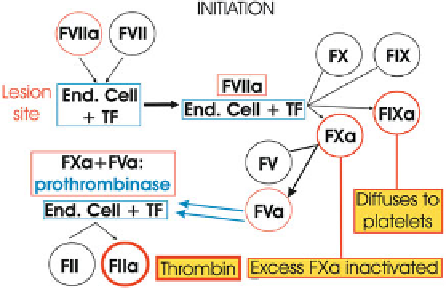Biomedical Engineering Reference
In-Depth Information
a fundamental step in the comprehension of the process, but as early as 2001 [37]
some evidence started emerging that the theory could need a deep revision. Experi-
mental facts that could not be explained in the framework of the cascade theory were
brought to attention in 2005 [38]. We will return to the 3-pathway cascade model
and its difficulties after we have exposed the currently accepted coagulation theory
(the so-called cell-based model). The extreme synthesis presented below is mostly
summarized from the papers already quoted about the vWF and from the following
articles: [15, 19, 36, 50, 51, 71, 85, 86].
The cell-based model identifies four distinct steps.
Initiation
When blood comes in contact with TF the tiny portion of FVIIa in the blood rapidly
produces a small quantity of the FVIIa-TF complex on the surface of the TF bear-
ing cells, with a twofold consequence: more FVII is activated, thus increasing the
amount of the same complex, and small amounts of FIXa and FXa are generated.
FXa is an activator of FV (available in blood) to FVa (though with not a high rate
constant) and then it binds to it on the TF bearing cell, forming the complex FVa-
FXa
(Prothrombinase)
. The latter acts on Prothrombin (FII), so that a small amount
of Thrombin (FIIa) becomes available. It is precisely this very small quantity of
Thrombin which triggers the main process (Fig. 3.1).
Some more considerations about the initiation stage are in order. There is evi-
dence that some coagulation factors can reach TF in nonvascular tissues even in the
absence of a lesion [99], thus making FIXa and FXa accidentally available. However
coagulation is not started because other indispensable ingredients (platelets and the
complex FVIII-vWF) stay only in blood. Moreover, a legitimate question is why co-
agulation initiated at a wound site proceeds to the clot formation at that site, without
spreading along the vessel. The answer is that FXa that happens to leak from the ini-
tiation site is rapidly inhibited by TFPI and AT-III (having a much milder action on
the FVIIa-TF complex), while whatever Thrombin that reaches healthy endothelial
cells is neutralized by binding with TM (see
Inhibitors
).
Fig. 3.1.
Cell-based model:
Initiation phase
of blood coagulation

